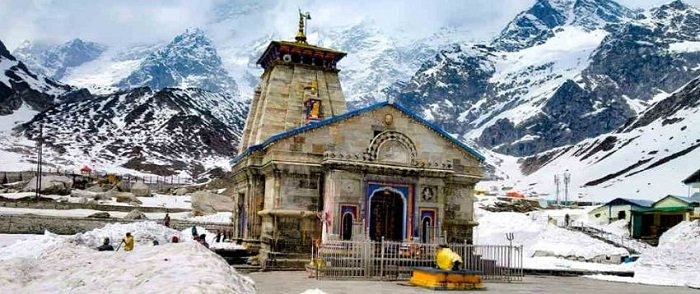Kedarnath is one of the 12 Jyotirlingas in India and Chardham Yatra in Uttarakhand. The temple is at an altitude of 3584 meters, near the river Mandakini. It was Adi Sankaracharya who established Kedarnath Dham and now it is one of the Hindu pilgrimage sites in India. Every year, lakhs of devotees from across the world go on the Kedarnath yatra to seek Lord Shiva’s blessings and attain Salvation (Moksha).
Standing tall near Mandakini, surrounded by the Himalayan range of the Garhwal region, Kedarnath has numerous legends or facts about Kedarnath connected to its history and origin. We have gathered exciting facts about the Kedarnath yatra that will blow your mind.
In case you are planning to go for the Kedarnath Yatra and wish to avoid the long 16-kilometer trek, LIH Travel offers Kedarnath Yatra by helicopter.
Ten Must-Know Facts About The Kedarnath Yatra
1. Guarded by Bhairon Nath-
Bhairon Nath temple is near the main temple. When the temple remains closed for six months after the Kedarnath yatra, Bhairon Nath Ji protects the Kedarnath temple from evil spirits and demons. Lord Bhairon Nath, also called Kshetrapal, was an avatar of Lord Shiva himself. Furthermore, locals believe that after visiting the Kedarnath temple, one must visit Bhairon Nath temple to complete their Teerth Yatra.
2. Pyramid Shape Shiv Lingam-
We know what Shiv Lingam generally looks like. But, the Shiv Lingam in Kedarnath is a triangular shape and is unique worldwide. Also, the Shiv Lingam is inside Garbha Griha of the temple. Goddess Parvati, Lord Krishna, Pandavas, Draupadi, Veerabhadra, and Nandi idols are inside the sanctum.
3. Lord Shiva protects Kedarnath-
The temple is indestructible and protected by Lord Shiva himself. People still remember landslides and floods in 2013 during the Kedarnath yatra, which destroyed the surrounding of Kedarnath, and many devotees and locals lost their lives. After everything, the temple stood tall like some cosmic power was protecting it from destruction. Moreover, people witnessed a boulder coming down the mountain and stopped a few meters away from the temple. Due to the boulder, the residue and water diverged the route, saving the Kedarnath temple. Today, that boulder is Bhimshila.
4. Mantra Chanting Is In A Different Language-
You must think, located in the North, the language must be Sanskrit. No, mantras chanted here are in Kannada.
5. Speciality About The High Priest
The High priest, Raval, is from the Veerashaiva Sangam community in Karnataka. The other priests in the temple conduct the puja on instructions by priest Raval. During the six months of the winter, when the temple remains closed, priest Raval moves with the deity to Ukhimath’s Omkareshwar temple. During that period, priest Raval worships the Lord in Omkareshwar temple.
6. Something Unusual About Deity Idol-
The idol of Lord Shiva in Kedarnath is decayed, and its head is in Nepal Bhaktapur’s Doleshwor Mahadev Tempe.
7. Mythological Importance In Shiv Puran-
There is a mythological saying in Shiv Puran that people who die in Kedarnath or on the way to Kedarnath receive instantaneous pardon of their sins.
8. Survived the Little Ice Age Era!
Did you know that the Kedarnath temple was under snow for more than 400 years before being discovered? So during the Little ice age era, the Kedarnath temple was a part of the glacier. 1300-1900 AD is a little ice age era where half of the earth was snow-covered. Moreover, it survived the movements of glaciers and rocks without any damage.
9. What is So special in Architecture?
If you’re someone who loves marvelous and ancient architecture, then the Kedarnath Temple’s architecture will blow your mind. Adi Shankaracharya reconstructed the current temple in the 8th century. The 80 feet wide, 187 feet long, and 85 feet high, the Kedarnath temple gives many reasons to go Kedarnath yatra. The temple roof is of a single stone, according to RK Dhobal. Even the experts are amazed by such a marvelous architecture existing for ages without any severe damage. The temple is at the plinth 6 feet above the ground and is constructed using gray stones. The thickness of the wall is 12 feet. The pedestal of Shiv Lingam is 3.6 meters in circumference and is 3.6 meters tall. Experts believe the temple is built using interlocking techniques for stones.
10. Older than the History
There is no documentation or other evidence of the history of the Kedarnath temple. According to beliefs and tales, Pandavas and Draupadi built the temple during their journey to heaven. Kedarnath is where they came to Lord Shiva to ask them for release from their sins of killing their blood. Lord Shiva took a form of an Ox to hide, but Bhima recognized him and battled him to come out. Lord divided and emerged into the earth, reappearing in different forms at different places, Hump at Kedarnath, arms Tunganath, face Rudranath, navel at Madhyamaheshwar, and hair locks at Kalpeshwar, creating a Panch Kedar. According to another legend, Kedarnath is where Goddess Parvati worshiped to unite with Lord Shiva to become Ardhanareeswarar.
Kedarnath Yatra Dates
The high priest at Omkareshwar Temple Ukhimath decides the opening and closing date of Kedarnath Yatra after going through Hindu Panchang calculations on the auspicious Maha Shivratri festival. Furthermore, the Kedarnath Yatra starts in April/May, on the auspicious Akshay Tritiya festival, and the door closes on Diwali or the day after it, after morning puja for six months.
Additionally, the closing date for Kedarnath Yatra 2022 is 26 October. However, the best time to visit Kedarnath is from April to June, when the weather is pleasant. As the monsoon starts, the area may receive heavy rainfall, making a trek to Kedarnath challenging.
Final Say
The registration is compulsory for Kedarnath Yatra and Chardham Yatra in Uttarakhand after 2014. One can register only online Kedarnath Yatra. Furthermore, you will receive a Biometric Pass after registration to everyone visiting Kedarnath. So carry it with your ID when visiting the temple.

